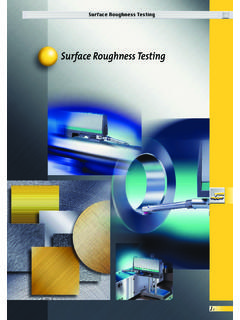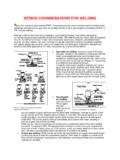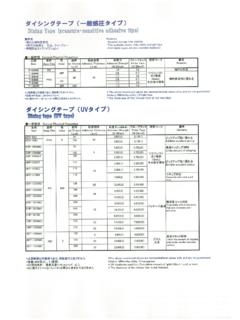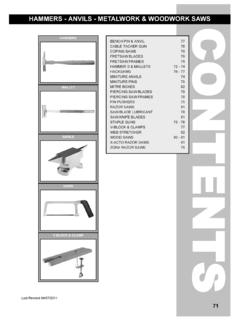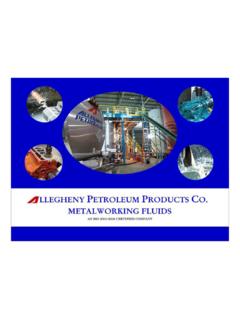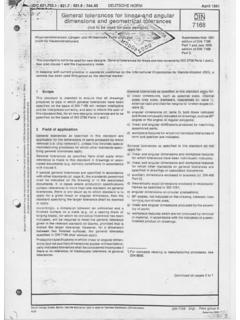Transcription of Working safely with metalworking fluids
1 Health and Safety Executive Working safely with metalworking fluids A guide for employees Introduction This leaflet aims to help employees who work with metalworking fluids understand the main risks to their health. It contains general advice on the precautions which you and your employer can take to avoid these risks. What are metalworking fluids ? metalworking fluids - sometimes referred to as suds, coolants, slurry or soap - are used during the machining of metals to provide lubrication and cooling, and to help carry away debris such as swarf and fine metal particles.
2 They can also help to improve machining performance and prolong the life of the cutting tool, as well as provide corrosion protection for the surfaces of workpieces. How can metalworking fluids affect you? metalworking fluids are mostly applied by continuous jet, spray, or hand dispenser. They can affect you: if you inhale the mist, aerosol or vapour generated during machining operations. Your exposure will depend on the type of machining you are doing and how well the machine is enclosed and ventilated. Exposure is likely to be highest: - near the metalworking machine.
3 - in operations involving high-speed tools or deep cuts;. - at machines where the process is not enclosed;. - where there are inadequate ventilation arrangements. through contact with the skin, particularly hands and forearms, if appropriate precautions (eg the use of gloves, overalls or face shields) are not taken. Skin contact can occur during the preparation or draining of fluids , handling of workpieces, changing and setting of tools, and during maintenance and cleaning operations. fluids can also splash onto you during machining, eg if there are no splashguards or if they are inadequate.
4 By entering your body through cuts and abrasions or other broken skin; or by entering your body through the mouth if you eat or drink in work areas, or do not wash your hands before eating or smoking. 1 of 5 pages Health and Safety Executive How can metalworking fluids affect your health ? Skin disorders All types of metalworking fluids can cause irritation of the skin or dermatitis. Neat oils in regular and prolonged contact with the skin can cause irritation of the hair roots. Also, fine microscopic metal particles, which are generated during machining, can damage the skin and make any existing irritation worse.
5 Dermatitis can be caused: by bacteria and their toxic by-products when these are present in the sump; through contact with sensitising agents such as chromium, nickel and cobalt, which can leach out from cutting tools and grinding wheels into metalworking Dermatitis usually fluids ; and affects the hands or by chemicals which are added to metalworking fluids , particularly for killing forearms - the parts of bacteria (biocides) and preventing corrosion. your body most likely to be in contact with Respiratory ill health metalworking fluids .
6 It can be very painful but Workers exposed to metalworking fluid mist and vapour have an increased risk of with care most cases can developing work-related asthma, bronchitis, irritation of the respiratory tract and be prevented. breathing difficulties. It can also cause extrinsic allergic aveolitis, which can cause increasingly severe breathing difficulties in recurrent episodes, following repeated exposure. Exposure may also cause irritation to the eyes, nose and throat. Under suitable conditions, bacteria and fungi can grow well in metalworking fluids .
7 Inhalation of these bacteria, fungi or toxic by-products can cause irritation of the respiratory tract or flu-like symptoms, as well as making existing asthma symptoms worse. Cancer In the past, the use of unrefined mineral oils led to skin cancer affecting the exposed skin, often hands and forearms. Also, oil-soaked clothing and oily rags kept in overalls caused cancer of the scrotum. Today, the use of highly refined oils and the substitution of cancer-causing chemicals in metalworking fluids , as well as changes in work practices and improved personal hygiene, have reduced the risk of cancer.
8 Working safely with metalworking fluids 2 of 5 pages Health and Safety Executive What precautions should you take? The more you know about the hazards associated with metalworking fluids and the precautions you should take, the safer you will be. General Follow the instructions and training given by your employer on safe systems of work when Working with metalworking fluids . Use splash guards, where provided, to control splashing and misting. Minimise the production of mist and vapour by controlling the volume and rate of delivery of the fluid to the cutting edge of the tool.
9 Use any enclosures or ventilation provided to remove or control any mist or vapour produced. Allow a time delay before opening the doors on machine enclosures to ensure that all mist and vapour have been removed by the ventilation. Report any damaged or defective splash guards, ventilation hoods or other control equipment. Open workroom doors and windows to improve natural ventilation. Don't use compressed air to remove excess metalworking fluids from machined parts or plant or equipment. Skin protection Reduce your contact with wet workpieces and surfaces.
10 Don't put your bare hands into fluid sumps or use oily rags to wipe them clean. Wear suitable gloves, overalls, aprons, goggles or face shields if needed (NB: Gloves can be hazardous if worn near rotating machinery or parts). Take care not to contaminate the inside of your gloves with metalworking fluids when putting them on or taking them off. You should ensure your hands are kept clean and in good condition. Using pre-work creams may help to make removing contaminants easier. They do not provide an effective barrier, and are not a substitute for gloves.










